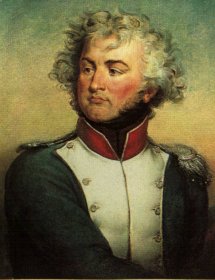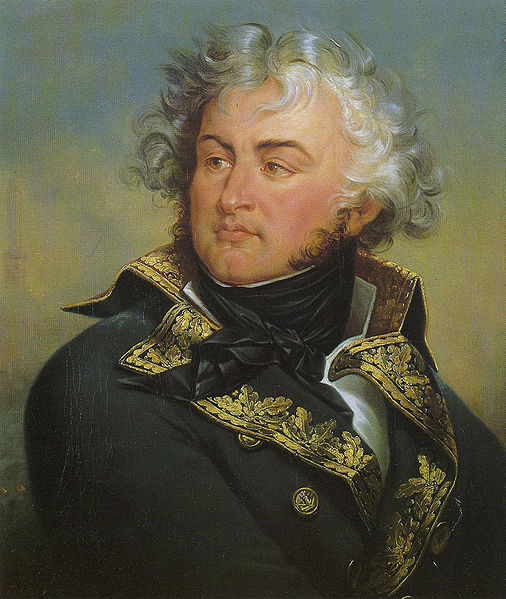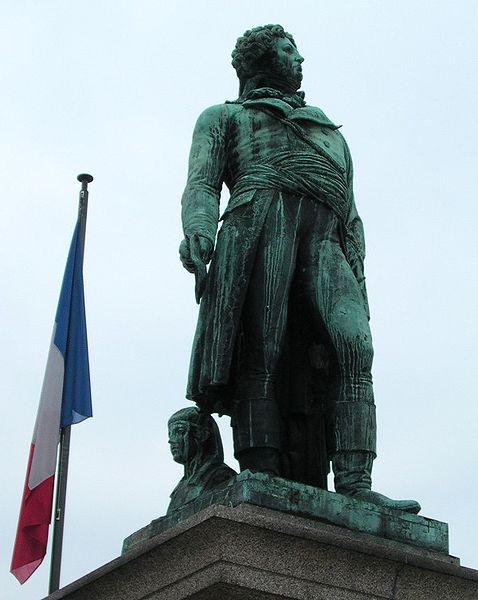<Back to Index>
- General of the French Army Jean Baptiste Kléber, 1753
- Writer and Revolutionary Honoré Gabriel Riqueti, comte de Mirabeau, 1749
- Ruler of Verona Cangrande I della Scala, 1291
PAGE SPONSOR



Jean Baptiste Kléber (9 March 1753 – 14 June 1800) was a French general during the French Revolutionary Wars. His military career started in Habsburg service, but his plebeian ancestry hindered his opportunities. Eventually, he volunteered for the French Army in 1791, and rose through the ranks.
Kléber served in the Rhineland during the War of the First Coalition, and also suppressed the Vendee Revolt. He retired to private life in the peaceful interim after the Treaty of Campo Formio, but returned to military service to accompany Napoleon in the Egyptian Campaign in 1798 - 99. When Napoleon left Egypt to return to Paris, he appointed Kléber as commander of the French forces. He was assassinated by a student in Cairo in 1800. Kléber was born in Strasbourg, where his father worked as a builder. He received, partly at Paris, training in architecture, but his opportune assistance to two German nobles in a tavern brawl obtained for him nomination to the military school of Munich. From this education, he obtained a commission in the Austrian army, but resigned it in 1783 on finding his humble birth hindered his chances for promotion. On returning to France he received the appointment of inspector of public buildings at Belfort, where he studied fortification and military science. In 1792 he enlisted in the Haut - Rhin volunteers. Due to his military knowledge he at once gained election as adjutant and soon afterwards as lieutenant - colonel.
At the defence of Mainz (July
1793) he so distinguished himself that though disgraced along with the
rest of the garrison and imprisoned, he promptly won reinstatement, and
became in August 1793 a general of brigade. He won considerable
distinction in the suppression of the Vendéans, and two months later gained promotion to general of division. In these operations began his intimacy with Marceau, with whom he defeated the Royalists at Le Mans and Savenay.
When he openly expressed his opinion that the Vendéans merited
lenient measures, the authorities recalled him; but re-instated him once more in April 1794 and sent him to the Army of the
Sambre - and - Meuse.
He displayed his skill and bravery in the numerous actions around Charleroi, and especially in the crowning victory of Fleurus (26 June
1794), after which in the winter of 1794 – 1795 he besieged Mainz. In
1795, and again in 1796, he held the chief command of an army
temporarily, but declined a permanent appointment as
commander - in - chief. On 13 October 1795 he fought a brilliant rearguard
action at the bridge of Neuwied, and in the offensive campaign of 1796 he served as Jourdan's most active and successful lieutenant. After the retreat to the Rhine, he again declined a chief command, he withdrew into private life early in 1798. He accepted a division in the expedition to Egypt under Bonaparte, but suffered a wound in the head at Alexandria in the first engagement, which prevented his taking any further part in the campaign of the Pyramids, and caused his appointment as governor of Alexandria. In the Syrian campaign of 1799, however, he commanded the vanguard, took El - Arish, Gaza and Jaffa, and won the great victory of Mount Tabor on 15 – 16 April 1799. When
Napoleon returned to France towards the end of 1799, he left
Kléber in command of the French forces. In this capacity, seeing
no hope of bringing his army back to France or of consolidating his
conquests, he negotiated the convention of El - Arish (24 January 1800) with Commodore Sidney Smith, winning the right to an honorable evacuation of the French army. When Admiral Lord Keith refused to ratify the terms, Kléber attacked the Turks at the Battle of Heliopolis. Although he had only 10,000 men against 60,000 Turks,
Kléber's forces utterly defeated the Turks on 20 March 1800. He then re-took Cairo, which had revolted against French rule.
Shortly after these victories, a Syrian student, Soleyman El - Halaby,
living in Egypt, knifed Kléber through the heart at Cairo on 14
June 1800, coincidentally, the same day on which his friend and comrade Desaix fell at Marengo. The assassin's right arm was burned off, and he was impaled in
a public square in Cairo and left for several hours to die. The
assassin's skull was shipped to France and used to teach French medical
students what the French authorities claimed was the bump of "crime"
and "fanaticism". The Encyclopedia Britannica provides the following assessment of Kléber: Kléber
emerged as undoubtedly one of the greatest generals of the French
revolutionary epoch. Though he distrusted his powers and declined the
responsibility of supreme command, there is nothing in his career to
show that he would have been unequal to it. As a second - in - command
no
general of his time excelled him. His conduct of affairs in Egypt at a
time when the treasury was empty and the troops were discontented for
want of pay, shows that his powers as an administrator were little - if
at all - inferior to those he possessed as a general.
After his assassination Kléber's embalmed body was repatriated to France. Fearing that his tomb would become a symbol to Republicanism, Napoleon ordered it held at the Château d'If, on an island near Marseille. It stayed there for 18 years until Louis XVIII granted Kléber a burial place in his hometown in Strasbourg. He was buried on 15 December 1838 below his statue located in the center of Place Kléber. His heart is in an urn in the caveau of the Governors beneath the altar of the Saint Louis Chapel in Les Invalides, Paris.